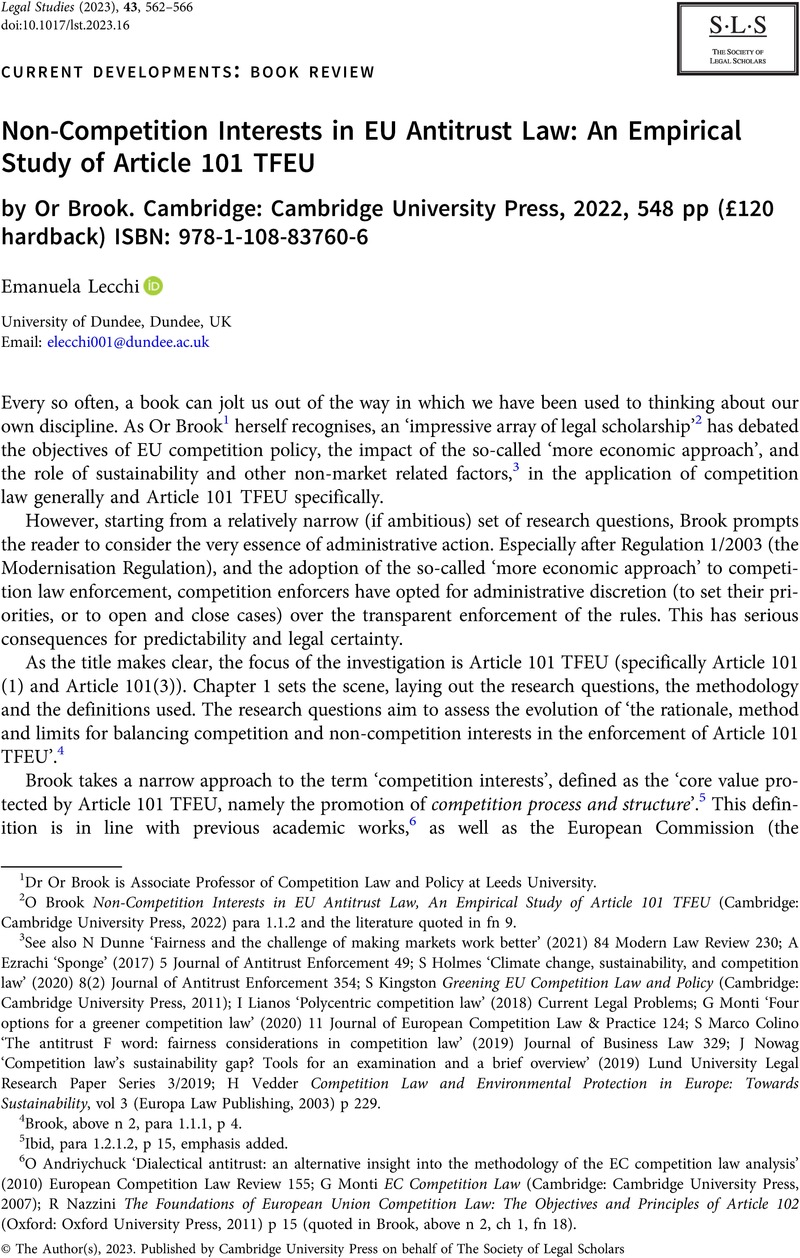No CrossRef data available.
Published online by Cambridge University Press: 12 May 2023

1 Dr Or Brook is Associate Professor of Competition Law and Policy at Leeds University.
2 Brook, O Non-Competition Interests in EU Antitrust Law, An Empirical Study of Article 101 TFEU (Cambridge: Cambridge University Press, 2022) para 1.1.2CrossRefGoogle Scholar and the literature quoted in fn 9.
3 See also Dunne, N ‘Fairness and the challenge of making markets work better’ (2021) 84 Modern Law Review 230; A Ezrachi ‘Sponge’ (2017) 5 Journal of Antitrust Enforcement 49CrossRefGoogle Scholar; Holmes, S ‘Climate change, sustainability, and competition law’ (2020) 8(2) Journal of Antitrust Enforcement 354CrossRefGoogle Scholar; Kingston, S Greening EU Competition Law and Policy (Cambridge: Cambridge University Press, 2011)CrossRefGoogle Scholar; I Lianos ‘Polycentric competition law’ (2018) Current Legal Problems; G Monti ‘Four options for a greener competition law’ (2020) 11 Journal of European Competition Law & Practice 124; S Marco Colino ‘The antitrust F word: fairness considerations in competition law’ (2019) Journal of Business Law 329; J Nowag ‘Competition law's sustainability gap? Tools for an examination and a brief overview’ (2019) Lund University Legal Research Paper Series 3/2019; Vedder, H Competition Law and Environmental Protection in Europe: Towards Sustainability, vol 3 (Europa Law Publishing, 2003) p 229Google Scholar.
4 Brook, above n 2, para 1.1.1, p 4.
5 Ibid, para 1.2.1.2, p 15, emphasis added.
6 O Andriychuck ‘Dialectical antitrust: an alternative insight into the methodology of the EC competition law analysis’ (2010) European Competition Law Review 155; Monti, G EC Competition Law (Cambridge: Cambridge University Press, 2007)CrossRefGoogle Scholar; Nazzini, R The Foundations of European Union Competition Law: The Objectives and Principles of Article 102 (Oxford: Oxford University Press, 2011) p 15CrossRefGoogle Scholar (quoted in Brook, above n 2, ch 1, fn 18).
7 Commission Notice, ‘Guidelines on the application of Article [101](3) of the Treaty (Art 101(3) Guidelines) [2004] OJ C101/97, para 105.
8 Brook, above n 2, para 1.2.1.1, p 13.
9 Ibid.
10 Ibid.
11 Ibid.
12 Ibid, para 2.2.3.1, p 42.
13 Ibid, para 1.2.1.1, p 12.
14 OFT ‘Article 101(3) – a discussion of narrow versus broad definition of benefits’ (30 November 2010), available at (Wayback Machine) https://web.archive.org/web/20101130003207/http://oft.gov.uk/shared_oft/events/Article101(3)-discussionnote.pdf (accessed 18 April 2023).
15 Brook, above n 2, para 2.2.3.1, p 41.
16 Ibid.
17 Ibid, p 5.
18 These are collected into a coding-book, available on request from the author. I acknowledge (with thanks) receipt of the coding book.
19 Interview ‘Or Brook on a novel approach to EU Competition Law’ (ACELG, 2019), available at https://acelg.uva.nl/content/news/2019/10/or-brook-on-a-novel-approach-to-eu-competition-law.html (accessed 18 April 2023).
20 Brook, above n 2, para 2.2.1.
21 Ibid, para 2.2.2.
22 Gerber, DJ Law and Competition in Twentieth Century Europe: Protecting Prometheus (Oxford: Oxford University Press, 1998) pp 335–369Google Scholar; Wesseling, R The Modernisation of EC Competition Law (Oxford: Hart Publishing, 2000) p 9Google Scholar; Rompuy, B Van Economic Efficiency: the Sole Concern of Modern Antitrust Policy? Non-efficiency Considerations under Article 101 TFEU (Wolters Kluwer, 2012) p 122Google Scholar: and SM Ramírez Pérez and S van de Scheur ‘The evolution of the law on Articles 85 and 86 EEC [Articles 101 and 102 TFEU] ordoliberalism and its Keynesian challenge’ in KK Patel and H Schweitzer (eds) The Historical Foundations of EU Competition Law (Oxford: Oxford University Press, 2013).
23 Case 26-76, Metro SB-Großmärkte GmbH & Co KG v Commission of the European Communities.
24 Brook, above n 2, para 3.3.3.4.
25 Ibid, para 3.3.3.5.
26 Article 101(3) Guidelines, above n 7, para 59.
27 Ibid, para 84.
28 Brook, above n 2, para 3.5.
29 Ibid, para 3.5.4.
30 See the findings presented in Brook, above n 2, Fig 3.2.
31 Brook specifically refers to L Kjolbye ‘The new commission guidelines on the application of Article 81(3): an economic approach to Article 81’ (2004) European Competition Law Review 566 at 573; and Faull, J and Nickpay, A The EC Law of Competition (Oxford: Oxford University Press, 2014)Google Scholar: see Brook, above n 2, para 3.4.4.4, fnn 194 and 195.
32 OECD Role of Efficiency Claims in Antitrust Proceedings (2012), Commission's answers to questionnaire.
33 The role of the BERs will not be considered further in this review.
34 This fundamental point is repeated throughout the book. For a short overview, see Brook, above n 2, para 1.1.2.
35 These are: cases aimed at balancing competition interests with ‘state or public interests’; and cases where the balancing happened between ‘competition and commercial interests’.
36 Brook, above n 2, para 5.5, p 292.
37 Ibid, p 294.
38 Ibid, para 8.2.2.
39 Ibid, Chapter 6. See also para 8.2.2.
40 Ibid, p 409.
41 Ibid, para 6.4, p 308.
42 Ibid, para 1.1.2, p 6.
43 Ibid, para 8.3.1, p 415.
44 Ibid, para 8.3.3.
45 Blog, B Rodger and O Brook ‘The first comprehensive empirical mapping of judicial review of competition law enforcement in the EU and the UK raises warning signs’ EULAW's Competition Corner (21 September 2022), available at https://eulawlive.com/competition-corner/the-first-comprehensive-empirical-mapping-of-judicial-review-of-competition-law-enforcement-in-the-eu-and-uk-raises-warning-signs/# (accessed 18 April 2023); V Robertson ‘The judicial review of national competition law decisions in Austria’ (2004-2021) (2022) Graz Law Working Paper No 15-2022.
46 Brook, above n 2, para 8.4.1.
47 Ibid, para 8.4.2.